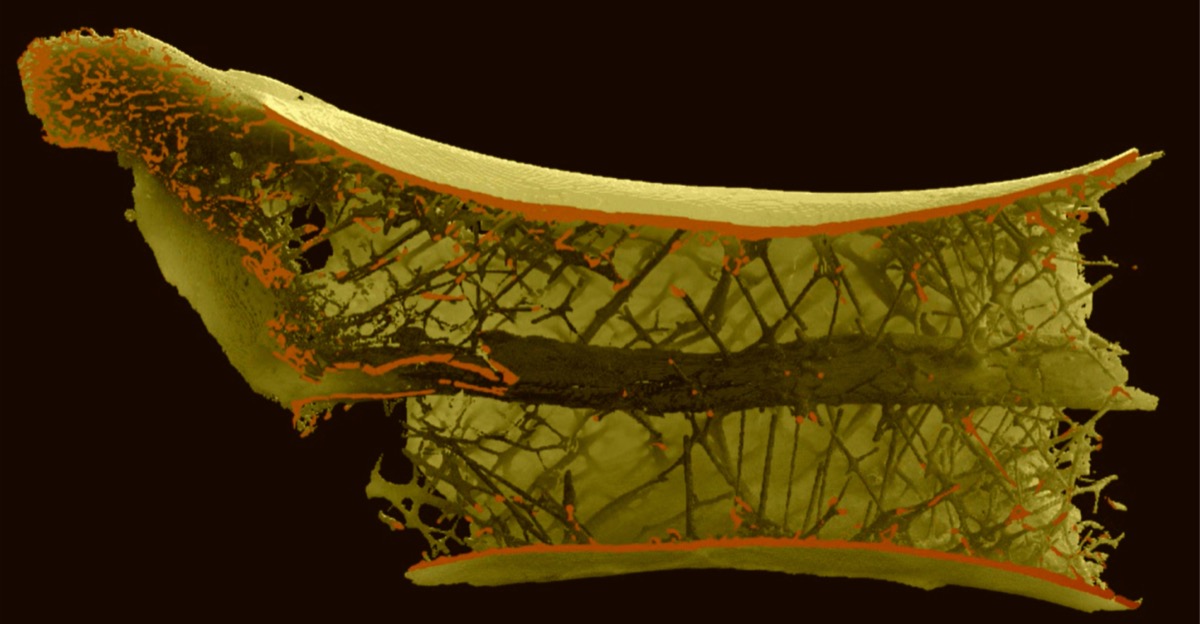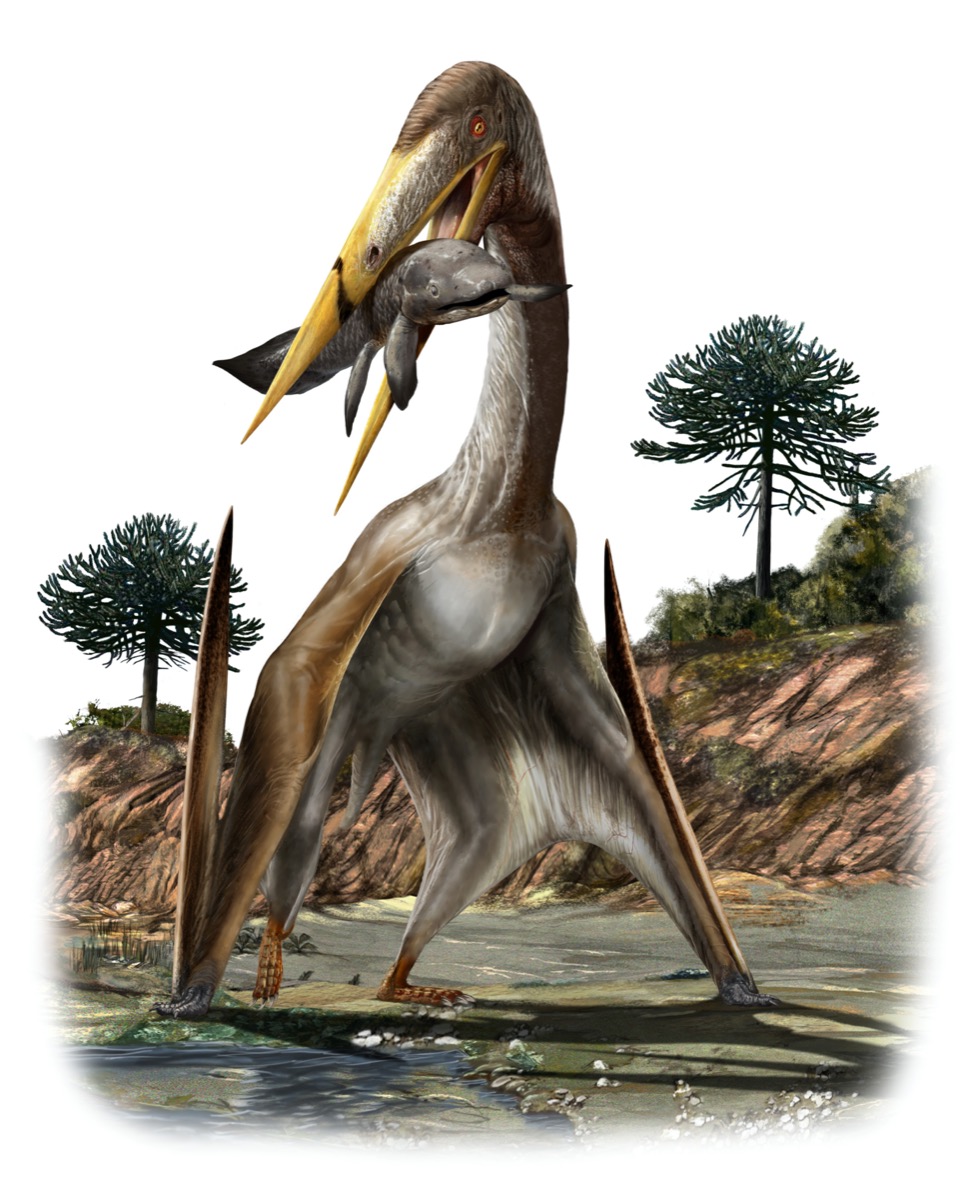Pterosaurs Had A 40-Foot Wingspan And A Giraffe-Like Neck
8:54 minutes

During the age of dinosaurs, there were all sorts of creatures flying through the air with different body shapes and sizes. One of those was a flying reptile called the azhdarchid pterosaur. This stork-like creature had the neck of a giraffe, and a 40-foot wingspan.
A group of scientists wanted to know more about the internal structure of the pterosaur’s long neck. Their results were published in the journal iScience. Paleontologist Nizar Ibrahim talks about what this pterosaur can tell us about the evolution of flight, and how it might inform our understanding of other prehistoric animals and dinosaurs found in Africa.

Invest in quality science journalism by making a donation to Science Friday.
Nizar Ibrahim is a paleontologist and anatomist at the University of Portsmouth in Portsmouth, England.
IRA FLATOW: During the age of dinosaurs, there was no air traffic control. It was probably out of control because there were all sorts of creatures flying through the air with different body shapes and sizes. One of those was a flying reptile called Azhdarchid pterosaur. Imagine a pelican-like creature with the neck of a giraffe and a 40-foot wingspan.
A group of scientists wanted to know more about the internal structure of the pterosaur’s ridiculously long neck. Their results were published in the journal iScience. My next guest is one of the authors on that study. Nizar Ibrahim is a paleontologist and anatomist, University of Portsmouth in Portsmouth, England. Welcome to Science Friday.
NIZAR IBRAHIM: Thanks so much for having me, Ira.
IRA FLATOW: Did I get that description right or could you be a little more specific?
NIZAR IBRAHIM: Well, it’s really difficult to describe these creatures because they’re kind of like dragons from deep time. There’s nothing alive today that really looks anything like a pterosaur. Pterosaurs are flying reptiles so they’re not bats or birds. They’re not related to those groups.
They have a really unique anatomy and some of them, in particular, the Azhdarchid pterosaurs reached gigantic sizes with wingspans of 10 meters or more so well over 30 feet. And figuring out how these creatures work is really challenging.
They have long necks, really long skulls, big wings, and Azhdarchid pterosaurs also looked like they were pretty competent walking around on land. So just think a giant stork hunting things on land. Some of them would have been as tall as a giraffe when standing on the ground. Working on these pterosaurs really is like working on extraterrestrials from outer space.
IRA FLATOW: Is a pterosaur classified as a dinosaur?
NIZAR IBRAHIM: No, they are kind of distantly related to dinosaurs but they are not dinosaurs. And so what we were trying to do in our work is look at the internal structure of the bones of these Azhdarchid pterosaurs.
IRA FLATOW: And tell us what you found especially about the neck bone. I understand that’s really interesting from a mechanical engineering point of view.
NIZAR IBRAHIM: Yeah, these animals have long necks. The neck bones are really slender and long, at least some of them are. They’re not all the same, of course. So for a long time, we’ve kind of reconstructed their necks in a fairly simplistic fashion as these long tubes. And so you would have the neural canal going through the middle, kind of like a tube within a tube.
But we know that these animals were in some cases, really, really big. And we know that they would have had to use their necks for all sorts of things to maybe, if they were catching prey on land, to try to strike down and catch prey and then lift prey up. So you’ve got a real conundrum there because you need some stability and some strength.
But then, of course, if you’re a flier, your bones are also very light and we know the pterosaurs had very thin bone walls. But we have this three-dimensionally preserved neck bone and using cutting edge technology, we’re able to look at the inside of this bone, CT scanning it.
And we saw this incredible network of bony struts, a little bit like the spokes in a bicycle wheel. They provided this incredible structure, very lightweight structure, that conferred a lot of additional strength and prevented buckling and catastrophic failure in the bone. So it’s a really impressive feat of biological engineering. You have this beautiful framework with these little spokes coming out and stabilizing the vertebra from the inside.
IRA FLATOW: This is Science Friday from WNYC Studios. If you’re thinking that some of these pterosaurs didn’t fly because they were too big or too heavy, why would they have the wings or would the wings evolve away?
NIZAR IBRAHIM: They were still capable of flight, even the really big ones. A couple of people suggested that maybe they were too big. But I think they still have the really big wings and attachment surfaces for very large muscles. They have the light bone. So they have all the telltale signs of fliers. So they were still flying, but they may have spend more time on the ground catching prey on the ground.
And there’s some really interesting stories about some of these giant pterosaurs. One type of these Azhdarchid pterosaur actually lived on, amongst other places, tiny islands in what is now Europe. One of those is known as Hateg Island. So there are discoveries mostly from Romania, what is today Romania.
You probably know there are some islands where dwarf elephants used to live, places in the Mediterranean where you see what we call island dwarfism. And you probably also know there’s a type of ancient human, Homo floresiensis that experienced island dwarfism on the island of Flores and what is Indonesia. Dinosaurs experienced the same sorts of evolutionary pressures.
And so you have these islands of dwarves so think long-necked dinosaur with a long tail but about the size of a pony instead of the length of three school buses. And so you had these tiny dinosaurs but then you also have these giant enormous flying reptiles. And, of course, the thing is the giant flying reptiles were not limited because they could fly wherever they wanted.
So they did not experience the same evolutionary pressures. If you’re a big flying reptile, you could fly anywhere you want. You can go to a big land mass. You’re not bound to island life. Everything is small, but then you’ve got these giant flying reptiles and they would probably scare the hell out of you if you were traveling back in time to this place. Some of them have a 3-meter long skull like about 9 feet, so pretty terrifying.
IRA FLATOW: That’s bigger than any big dinosaur.
NIZAR IBRAHIM: Many people don’t realize just how big these things were and even for us as paleontologists, it’s really hard to wrap your head around this.
IRA FLATOW: The Azhdarchid pterosaur fossil was found in Morocco, and I know that you studied dinosaurs in Africa. What were the age of dinosaurs over there look like? Were there T-rexes, Stegosaurus, these types of dinos or were they completely different animals?
NIZAR IBRAHIM: So one of the things I’m trying to do as kind of like an overriding theme to my research is I’m trying to tell the story of Africa’s age of dinosaurs. And it was very different. So the world our pterosaur lived in, for example, was a very strange one. These fossils were found in the Sahara desert, which is one of the driest and most inhospitable places in the world today.
But about 100 million years ago, this place that we now call the Sahara was home to a huge river system. It was home to several T-rex-sized predatory dinosaurs. No T-rex though– very different ones, including a crocodile-snouted, sail-back dinosaur called Spinosaurus, fish-eating predatory dinosaur, as well as lots of crocs and turtles and flying reptiles, giant car-sized fish. A really, really strange sort of ecosystem. And so that really serves as a reminder that there are many, many places in the world we haven’t really explored.
IRA FLATOW: Speaking of which, then what are some of the big questions you have about dinosaurs in Africa to fill in the picture?
NIZAR IBRAHIM: Well, Africa is important not just because it’s a really big place but also because there are some geological layers that are not well represented in other parts of the world. But they are present in Africa.
So discoveries from Africa can shed light on the early evolution of some dinosaur groups we know from places like North America. Another thing we can do in Africa is to test the idea that our African dinosaur fossil assemblage is simply replicating what we see in other parts of the world, like Europe and North America, or are they very different? And as I said a moment ago, they seem to be very different.
And we can also learn things about the very end of the age of dinosaurs. One of the big questions in dinosaur paleontology is were the dinosaurs on their way out when the big meteorite hit our planet or were they still very successful? Some people are saying, well, in North America, there’s some evidence suggesting that dinosaurs were already becoming less diverse and they’re kind of on their way out.
But there are some places in Africa, where we can look at some of the very last dinosaurs alive before the end of their reign and we might see something very different. A lot of it is about just improving our data sets. Right now, many people don’t realize just how biased our data sets are. They’re really very Western-centric in many ways.
IRA FLATOW: This has been fascinating, Nizar. Thank you for taking time to be with us today.
NIZAR IBRAHIM: Sure, my pleasure. Nizar Ibrahim is a paleontologist and anatomist, University of Portsmouth, Portsmouth, England.
Copyright © 2021 Science Friday Initiative. All rights reserved. Science Friday transcripts are produced on a tight deadline by 3Play Media. Fidelity to the original aired/published audio or video file might vary, and text might be updated or amended in the future. For the authoritative record of Science Friday’s programming, please visit the original aired/published recording. For terms of use and more information, visit our policies pages at http://www.sciencefriday.com/about/policies/.
Alexa Lim was a senior producer for Science Friday. Her favorite stories involve space, sound, and strange animal discoveries.
Ira Flatow is the founder and host of Science Friday. His green thumb has revived many an office plant at death’s door.